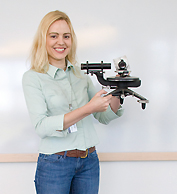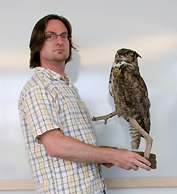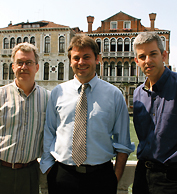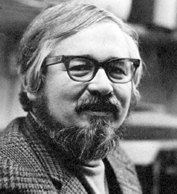STILLPOINT Archive: last updated 10/28/2019
Fish, Squid and Flapping-Fin Robots
Erik Anderson, Ph.D. '89
I am assistant professor of mechanical engineering, Grove City College, Grove City, Pennsylvania. I teach fluid mechanics and biomechanics, and a core course focusing on the intersection of faith and science, specifically focusing on origins, bioethics and environmental issues. I also do research at Woods Hole Oceanographic Institution and at Harvard in the field of biofluid dynamics and biomimetic robotics. The goal is to design better oceanographic and marine vehicles by first looking at how marine animals swim, specifically fish and squid. The flapping-fin robot I built at Harvard made the cover of the Journal of Experimental Biology in August 2007.
I was in Irvin Levy's Organic Chemistry class at Gordon. He had a unique nomenclature for tests and homework, if I remember correctly. I think he called tests "recitals"--or maybe it was "opportunities." His approach to teaching had a major impact on my teaching style, first while I was a high school teacher and now as a college professor.
Peace-Corps Physics
Rebekah Fisher '05
I recently returned from working as a Peace Corps volunteer in a village in southern Tanzania. I taught physics and physical science at a public secondary school where I was the only non-Tanzanian. Now I am teaching sixth-grade science and math at Wamsutta Middle School in Attleboro, Massachusetts. I love working with young people and breaking information down into something that is enjoyable and applicable to their lives. In both jobs I have had the challenge of improving the test scores of my students, and engaging and exciting them with the material. My more important challenge, however, has been breaking down barriers that separate us from one another. It amazes me how similar we humans are from culture to culture. I want my students to embrace the diversity God created.
New Technology and Physical Subtleties
Anan Copty '94
For the last four years I have worked at Intel Corporation in positions ranging from research and development of novel technologies to device physicist for the 45nm transistors. I am currently involved in the startup of a $4 billion facility in Qiryat Qat, Israel, which will manufacture the latest 45nm technology of Intel processors. I enjoy working on new technologies and delving into the physical subtleties involved. From previous experiences, one of my most significant contributions was a paper on the interaction of microwave and biological proteins that I published while in graduate school. As the public use of cellular phones (radiating microwaves) is continuously increasing, there needs to be more scientific work on their subtle effects on biology--and therefore our health.
Warblers, Tanagers, Thrushes and Orioles
by Abigail Geer '08
Dr. Gregory Keller, son of two "quiet naturalists," recently joined the Gordon biology faculty and relishes the opportunity to share his love for God as he shares his love for science. Keller was drawn to Gordon because he was fascinated by the question of whether science and faith could be successfully integrated, but he feared that the experiment would be either "the greatest or most nightmarish combination." He has found the best of both worlds here.
His work focuses on the landscape factors that affect the populations of migratory birds, and what can be done to prevent population decline. He enlists his students' help, giving them both valuable experience and tools through which to appreciate the beauty of the world around them.
Keller's interest in birds began at his family's birdfeeders. "It's hard not to be passionate about birds," he says, "after being surrounded by hundreds of rainbow-colored warblers, tanagers, thrushes and orioles foraging on caterpillars at 5 a.m on a cold, drizzly morning. Appreciation turns quickly to admiration, then to awe when one realizes that a bird that weighs the same as four pennies migrates 3,000 miles and loses half of its body weight just to breed in our woods. The songs they sing are unrivaled by humans and other animals, and are essentially a song of praise and declaration of success. Deep down the better question is, 'Are there any better representatives of God's creation in both beauty and perfection?'"
Faith and Science in Venice
Karl Giberson, director of Gordon's new Forum on Faith and Science, led a one-week science and religion seminar in May at Venice's prestigious Istituto Veneto di Scienze, Lettere ed Arti. This year's theme was "God and the Laws of Nature." Funded by the John Templeton Foundation, the competitive program brings together promising graduate students and young scholars while also guiding established scholars interested in contributing to some of the most important interdisciplinary conversations of our time. Among the participating scholars were Associate Professor of Biology Craig Story, who presented "The God of Christianity and the GOD of Immunology"; and Brian Glenney, assistant professor of philosophy, who presented "God, Laws of Nature, and Natural Miracles." Featured speakers were Sir John Polkinghorne, Anglican priest and former professor of mathematical physics at Cambridge University; Owen Gingerich, professor emeritus of astronomy and of the history of science at Harvard University; and Paul Davies, physicist, science writer, and broadcaster.
www.vssr.info
Connecting Worlds
by Abigail Geer '08
Emily Jarvis' quiet demeanor parallels the quantum chemistry she studies. As with the compounds that form our world but are unseen even to the strongest microscope, there is more to Jarvis than is immediately apparent.
Jarvis earned her doctorate from the University of California at Los Angeles, was a Congressional science fellow, and has worked as a National Research Council postdoctoral research scientist. At UCLA she studied quantum chemistry and the interactions that take place between a few hundred molecules of a substance, using mathematical models to extrapolate how large quantities of the same substances would interact with each other. Jarvis has also studied the jet engines' coatings that allow the engines to function at super high temperatures, attempting to determine how to prevent unwanted interactions between the coatings and the air sucked into the engines. During her time in Washington, Jarvis served as a liaison between the scientific community and legislators, explaining scientific matters to members of Congress.
"A couple things make me passionate about science," she says. "First, physical science is so fundamental to our world. It explains things as diverse as how my computer works and what makes a sunset beautiful. Secondly, the extreme complexity and yet the orderliness and mathematical basis of the world around us points to God and our relationship with Him and how He communicates Himself through the elegance of the world." She adds, "It's exciting to be surrounded by other people who are taking their faith seriously and the added meaning that brings to their work."
Inspiration, Humor and Friendship: A Tribute to Dr. Tom Dent
Carol Gordon '89
Such fond memories I have of Dr. Dent, who called me "wee tiny little Carol" and yet challenged me to stand tall. He opened a wonderful world to us--botany--throwing us into every opportunity possible to let us experience God's creation out of the textbook and inside flowers, walking among forest trees, tasting the fruits and nuts they bore. In 1988 during spring break Dr. Dent took seven of us to Florida to volunteer at ECHO (Educational Concerns for Hunger Organization), to see firsthand practical ways to serve Christ by helping farmers around the world feed their communities. That trip changed my life. After Gordon I returned to ECHO to work on their demonstration farm. Although I subsequently worked several years at the U.S. National Arboretum, my heart longed to work with farmers again. I didn't return to that dream until after Dr. Dent's death. I studied agronomy at the University of Maryland and dedicated my master's thesis to Dr. Dent. How I wish I could tell him that I am now happily working with farmers as a soil conservationist in Maryland. I thank God for Dr. Dent, for his believing in me, his inspiration, humor and sincere friendship.
A Time to Reunite
Anna Martin
Jane Andrus, Russ Camp, Tom Dent, Jack and Ann Haas, Jerry McNatt. These men and women played vital roles in developing the Natural Sciences Division at Gordon College. Alumni now have the opportunity to honor these retired faculty members in lasting and heartfelt ways.
Many alumni have taken the opportunity to visit the testimonial pages for science and psychology faculty. Testimonies and memories are compiled and given to the faculty member, or his family, as a memory book.
Alumni have also gathered at a series of reunion events honoring specific science faculty members and recognizing them for their years of dedicated service and commitment. More major-specific events will occur in the coming year.
In gratitude for their foundational work in building Gordon's science program, we are delighted to announce that the several laboratories and other areas in the Ken Olsen Science Center will be named in honor of these devoted retired faculty members. These include the Dr. Russell R. Camp Molecular Cell Biology Laboratory; the Dr. Jerrold L. McNatt Physics Laboratory; and the Dr. Michael W. Givens Kinesiology Seminar Room.
For decades committed faculty members nurtured the science programs in spite of inadequate facilities, tired equipment and little budget. What these professors lacked in physical resources they made up for in dedication and hard work, ensuring their students' readiness for graduate study or the workplace. Their legacy is now honored by the new Science Center-a wonderful reason for alumni to reunite and celebrate.
The Best of Both Worlds: 3-2 Engineering
Abigail Geer '08
In the basement of the Ken Olsen Science Center, construction is underway on an engineering lab. When complete, it will be among the few dedicated labs found at liberal arts colleges in the United States. The new lab will strengthen the 3-2 engineering program already in place at Gordon, in which students spend three years at Gordon building a foundation, then enroll in an engineering school for their final two years, receiving degrees from both Gordon and the engineering institution they attend. Viterbi School of Engineering at the University of Southern California has recently formalized its partnership with Gordon's 3-2 program.
The program provides engineering tracks in aerospace, mechanical, astronautical, biomedical, chemical, civil, environmental, computer, computer science, electrical, industrial and systems.
David Lee, Ph.D., associate professor of physics and 3-2 program coordinator, says, "Our 3-2 students must be prepared to become uncompromisingly good engineers, but they must also have more than just a framework of faith; they must understand engineering from the proper perspective of God's total ownership of creation. They must understand that our knowledge, actions and works are outpourings and manifestations of His redemptive love toward creation. With this grounding, and coupled with the breadth of exposure and the solid thinking and communication skills that characterize our Gordon education, these students will begin their mission work the minute they set foot at an engineering institution, surrounded as they will be by nonbelieving peers, teaching assistants and professors. They must be ready for the academic challenges, of course, but they must also be ready to defend their faith in a way that will impact their fellow engineering students. What better way to prepare future leaders in these fields than by combining the very best aspects of
the Christian liberal arts education with the very best training at an engineering institution?"
For information about the 3-2 program, contact [email protected].



